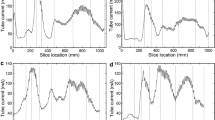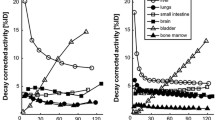Abstract
In a whole body PET/CT (positron emission tomography/computed tomography) scan, lifting the patient’s arm to improve the image quality is natural. On the other hand, the arms should be placed lower when the lesion is located in the head and neck. This study compared the CT effective dose for each arm position after applying AEC (automatic exposure control). Forty-five patients who had undergone an 18F-FDG (fluorine-18-fluoro deoxy glucose) whole body PET/CT scan were examined using Biograph Truepoint 40, Biograph Sensation 16, and Discovery STe 8 systems. The CT effective dose of 15 patients for each set of equipment was measured and analyzed comparatively in both the arm-lifted and arm-lowered positions. The ImPACT Ver. 1.0 program was used to measure the CT effective dose. A paired t-test (SPSS 18.0 statistic program) was applied for statistical analysis. In the case of the arm-lifted position, the CT effective dose measured for Biograph 40, Biograph 16, and DSTe 8 systems were 6.33 ± 0.93 mSv, 8.01 ± 1.34 mSv, and 9.69 ± 2.32 mSv, respectively. When the arms were located in the lower position, the respective CT effective doses were 6.97 ± 0.76 mSv, 8.95 ± 1.85 mSv, and 13.07 ± 2.87 mSv, respectively. These results revealed 9.2%, 10.5%, and 25.9% improvement in the CT effective doses for the Biograph 40, Biograph 16 and DSTe 8 systems, respectively, when the arms were raised compared to that when they were lowered (p < 0.05). For the whole body PET/CT case, the CT effective dose applying AEC showed a mean 15.2% decrease in the radiation exposure of the patients when the arm was lifted. The patient with no lesion in the head and neck would show fewer artifacts in the objective part and a lower CT effective dose. For a patient with a lesion in the head and neck, the artifacts in the objective part can be reduced by putting the arms down. The fact that the CT effective dose is increased in a whole-body PET/CT scan should be a concern.
Similar content being viewed by others
References
D. W. Townsend and T. Beyer, Brit. J. Radiol. 75, 24 (2002).
T. Beyer, D. W. Townsend, T. Burn, P. E. Kinahan, M. Charron, R. Roddy, J. Jerin, J. Young, L. Byars and R. A. Nutt, J. Nucl. Med. 41, 1369 (2000).
P. Dawson, Brit. J. Radiol. 77, 10 (2004).
S. J. Yates, L. C. Pike and K. E. Goldstone, Brit. J. Radiol. 77, 472 (2004).
G. R. Iball, D. S. Brettle and A. C. Moore, Brit. J. Radiol. 79, 62 (2006).
S. Rizzo, M. Kalra, B. Schmidt, T. Dalal, C. Suess, T. Flohr, M. Blake and S. Saini, Am. J. Roentgenol. 186, 673 (2006).
C. H. McCollough, Radiology 237, 755 (2005).
T. J. Beyer, Nucl. Med. 45, 29 (2004).
D. Delbeke et al., Nucl. Med. 47, 885 (2006).
C. H. McCollough, M. R. Bruesewitx and J. M. Kofler, RadioGraphics 26, 503 (2006).
L. M. Hamberg, J. T. Rhea, G. J. Hunter and J. H. Thrall, Radiology 226, 762 (2003).
M. F. McNitt-Gray, RadioGraphics 22, 1541 (2002).
European Commission, Report EUR 16262, Quality Criteria for Computed Tomography, 1999.
International Electrotechnical Commission, IEC 60601- 2-44, Medical Electrical Equipment. Part 2-44: Particular Requirements for the Safety of X-ray Equipment for Computed Tomography, 2002.
European Commission, EUR 16262, European Guidelines on Quality Criteria for Computed Tomography, 2000.
M. K. Kalra, S. M. Rizzo and R. A. Novelline, Emerg. Radiol. 11, 267 (2005).
M. K. Kalra, M. M. Maher, T. L. Toth, B. Schmidt, B. L. Westerman, H. T. Morgan and S. Saini, Radiology 233, 649 (2004).
M. K. Kalra, N. Naz, S. M. Rizzo and M. A. Blake, Curr. Probl. Diagn. Radiol. 34, 171 (2005).
N. Keat, MHRA evaluation report 0516, CT scanner Automatic Exposure Control Systems, 2005.
M. Soderberg and M. Gunnarsson, Acta. Radiol. 6, 625 (2010).
C. H. McCollough, Radiology. 237, 755 (2005).
M. K. Kalra, S. M. Rizzo and R. A. Novelline, Emerg. Radiol. 11, 267 (2005).
L. W. Goldman, J. Nucl. Med. Technol. 35, 213 (2007).
M. Lewis, N. Keat and S. Edyvean, NHS Report No 06013, 32 to 64 Slice CT Scanner Comparison Report Version 14, 2006.
Author information
Authors and Affiliations
Corresponding author
Rights and permissions
About this article
Cite this article
Seong, JH., Park, SK., Kim, JS. et al. A comparative study on the CT effective dose for various positions of the patient’s arm. Journal of the Korean Physical Society 61, 1137–1142 (2012). https://doi.org/10.3938/jkps.61.1137
Received:
Accepted:
Published:
Issue Date:
DOI: https://doi.org/10.3938/jkps.61.1137




